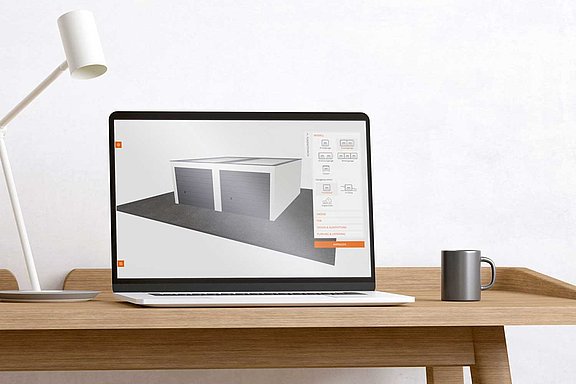How configurators are conquering the construction industry
Author: Klaus Pilsl
In a rapidly digitizing world, the construction and building components industries are at a crucial turning point. For years, these traditional sectors have relied on tried and tested methods - but times are changing and companies are now under intense pressure. The introduction of product configurators marks a revolution that is fundamentally changing the way we build and design. While the hammer and the tape measure will always have their place, digital transformation is creating new benchmarks - and challenges.
Many companies are still at the beginning of the digital journey, especially in sales, where personal contact and handshake quality have set the tone so far. However, customer expectations are evolving, driven by a world in which almost everything can be configured and personalized with just a few clicks. So how can companies in the construction and construction elements industry embrace and utilize this change to not only survive, but thrive? And why is there such an urgent need for action for these companies? That's what this article is all about.
What is a configurator
Definition and explanation
First of all, a few definitions:
The construction industry refers to products and services relating to e.g. buildings, infrastructure, landscaping and gardening, renovation and conversion work, etc.
The building elements sector includes products and services relating to building materials (bricks, glass, insulating materials, etc.), windows and doors, facades, permanently installed furniture and equipment for the home and garden, sanitary and furnishing installations, etc.
It is irrelevant whether the products are sold directly to the consumer or to production or service companies. The only differences lie in the scope, content and focus of the solutions. For the sake of simplicity, we will summarize both industries under the term "construction industry" in this article.
Different types of configurators in the construction industry
There are various tools in digitalized or partially digitalized sales. A basic distinction is made between planning tools and configurators.
Planning tools have open solution spaces and must therefore be operated by experts, the sales employees.
However, configurators only allow predefined, rule-checked configurations and can therefore be operated by anyone. Among configurators, a distinction can also be made between e-commerce configurators and sales support configurators. The former become a direct part of the web store, while the latter support the sales staff in their discussions with customers.
And e-commerce configurators can also differentiate between whether customers can buy the product online immediately or make a specific request to the company.

Configurator checklist
Avoid stumbling blocks.

Where does the high demand in this sector come from
The current situation
The construction industry is facing major challenges today: Cost price increases are particularly high (raw material prices, supply chains, inflation, energy, staff wage increases) (see price trends in the construction industry), while, on the other hand, demand is falling sharply due to regulatory measures and high interest rates. This inevitably leads to high pressure to reduce costs.
These companies are therefore particularly looking for ways to reduce costs and increase sales.
For many static products - products that do not require configuration - sales digitization has already been implemented in recent years. With success: the distribution costs for these products are now in the low single-digit range.
But what about configurable products? These are often consulting-intensive and therefore generate much higher costs. Manufacturers often sell these products via specialist retailers, who alone need a margin of 20-40%, depending on the product (not including sales training, sales materials, communication costs, etc.). It is therefore obvious that the sales process needs to be simplified and accelerated through digitalization.
Time savings for planning and design
Configurators can be operated directly online by consumers without any detours.
Advantages:
- Customers get a solution immediately
- Teach the Customer: Customers get all their questions answered immediately (price, design, options, presentation of THEIR product, delivery time, etc.).
- Product can be offered at a significantly lower price if the manufacturer passes on the reduction in distribution costs
- This makes the manufacturer more competitive
Disadvantages:
- Creating the configurator involves effort (conception, standardization, data procurement, fine-tuning)
Speed wins:
However, it is also important for a company to continuously adapt its range of services to the requirements of its customers. To do this, the manufacturer needs customer feedback. This works very simply with digitalized sales. Here, the manufacturer has the analysis data of the customer's configuration behavior. This allows the manufacturer to react and continuously adapt their product to their target group. And as soon as the manufacturer wants to roll out these product innovations, another advantage of digital sales becomes apparent: product changes can be implemented very quickly in the configurator. No product training is necessary because the users (sales staff or consumers) get to know all product characteristics and special features through the configurator. Price changes, new colors, materials or promotions can also be made on a daily basis. This not only reduces direct sales costs, but also sales expenses when introducing product innovations.
Customization options / individual adaptation options
Only through the necessary standardization of the product can the scaling mechanisms be used in sales and implementation. This in no way means that the product is rigid and inflexible. However, it does mean that all variations and characteristics must be defined during product development with all their consequences (price, combinatorics, visualization, etc.), and this can be a challenge for products in the construction industry - such as entire houses. But it is worth it.
Improvement of the sales process
In most cases, digitalization is also changing the sales process itself. Basically, every sales process begins with the customer at the moment they decide to look for a solution. Today, this search starts almost exclusively online. When customers land on the website of the product manufacturer or retailer, they start to find out more about the product. This is where the customer journey changes.
While customers contact the manufacturer/retailer in the conventional sales process, customers now enter the website's product configurator. And here they can immediately design the product and get to know it. They can save the configuration and continue at a later date. The information that the configurator continuously presents to customers is equivalent to a continuously updated product range. The only difference is that this does not have to be repeatedly created in a time-consuming process, but that customers can see it immediately and continuously. And as soon as the configurator has answered all of the customer's questions and the solution meets the customer's requirements, the customer can order the product online immediately.
In contrast to the conventional sales process, no personnel and consulting costs are incurred up to this point.
Error minimization and improved accuracy
As soon as the customer has ordered online, the order phase of the sales process begins. Since the order is already fully defined due to the closed solution space and the technical checks by the configurator, production control can also be fully automated from this point onwards. This also eliminates manual order preparation costs, which also reduces the error rate and lowers error costs.
This means that the sales process not only results in significant cost savings in product identification and design with customers, but also triggers cost savings on the manufacturer side.

Successful configurator projects from the construction industry
Here are some of our customers who are already successfully implementing this sales digitization:
- The company Bückeburger manufactures hall offices for production halls, for example. The configurator allows their customers to get to know and design the product at a very early stage. As a result, Bückeburger receives more inquiries (leads), which also have a higher quality (conversion rate).
- Pieno manufactures premium entrance doors. The product configurator is not only used in the web store for direct ordering, but also serves as a sales support tool in showrooms. Pieno uses the configurator as a central element in the sales process and has already achieved a 10 % cost reduction compared to conventional sales.
- The company Barbecue Kitchen sells garden kitchens. Since the introduction of the configurator, the customer journey has changed dramatically: Instead of manually designing, calculating and ordering the product with the sales team as before, customers now do these tasks themselves with the help of the configurator. And this has been so successful that Barbecue Kitchen has decided to only offer this direct sales channel.
Highlights of using a configurator in the construction industry
The following configurator options are particularly popular in this sector:
- Augmented Reality (AR): Customers want to see what they are buying. With AR, they can see the configured product virtually in advance at the intended location and view it from all sides.
- Automatic generation of parts lists: This makes it easy to automate production control. The configurator determines all production data and transfers it to the production system (ERP, PPS, etc.). This saves costs and eliminates processing errors
- Interactive 3D graphics: Even while the customers are designing the product, they can immediately see exactly what the product will look like. This creates security and confidence that they will get exactly what they have configured. The 3D graphics can also be used to provide advice: Customers learn what effects the configuration parameters have and can also see exactly how the product will behave through animated graphics, for example.
- Checked solution space: Unlike planning software, the configurator only allows technically correct configurations. Users can be confident that everything they design in the configurator is also available and correct.
Conclusion and future trends
Configurators are revolutionizing the construction industry through digitalization and increased efficiency. They offer personalized solutions, reduce sales costs and improve the customer experience. The following trends can be identified:
- Advanced personalization: Advanced configurators offer more options and flexibility.
- Use of AR and VR: For a more realistic customer experience in project design.
- Automated production: Direct connection of configurators to production processes for more efficient implementation.
- Ecological sustainability: Promotion of environmentally friendly building products.
- Use of data analyses: Improvement of product offerings based on customer feedback.
- Mobile platforms: More accessible and user-friendly configuration platforms.
Configurators are central to the digital transformation and will continue to play a key role in shaping developments in the construction industry.
Would you like to talk to experts about whether your product or company is suitable for implementing a configurator? We are at your disposal for a non-binding discussion.


Configurator checklist
Avoid stumbling blocks.


